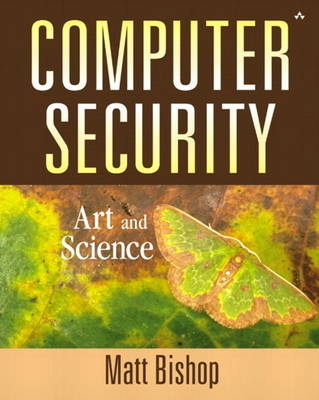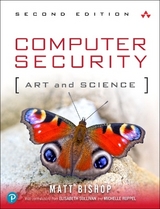
Computer Security
Addison-Wesley Educational Publishers Inc (Verlag)
978-0-13-428951-9 (ISBN)
- Titel erscheint in neuer Auflage
- Artikel merken
The most complete book on information security theory, technology, and practice from a well-recognized security authority and educator.
Matt Bishop is an expert in information assurance and robust, safe code- important topics today.
Current with the latest developments.
Well-suited to become the leading security textbook.
NOTE: This book is now printed in two volumes
Matt Bishop is a professor in the Department of Computer Science at the University of California at Davis. A recognized expert in vulnerability analysis, secure systems/software design, network security, access control, authentication, and UNIX security, Bishop also works to improve computer security instruction.
(NOTE: Each chapter, except chapter 29, concludes with a Summary, Research Issues, Further Reading, and Exercises.)
Preface.
Goals.
Philosophy.
Organization.
Roadmap.
Dependencies.
Background.
Undergraduate Level.
Graduate Level.
Practitioners.
Special Acknowledgment.
Acknowledgments.
I. INTRODUCTION.
1. An Overview of Computer Security.
The Basic Components.
Confidentiality.
Integrity.
Availability.
Threats.
Policy and Mechanism.
Goals of Security.
Assumptions and Trust.
Assurance.
Specification.
Design.
Implementation.
Operational Issues.
Cost-Benefit Analysis.
Risk Analysis.
Laws and Customs.
Human Issues.
Organizational Problems.
People Problems.
Tying It All Together.
II. FOUNDATIONS.
2. Access Control Matrix.
Protection State.
Access Control Matrix Model.
Access Control by Boolean Expression Evaluation.
Access Controlled by History.
Protection State Transitions.
Conditional Commands.
Copying, Owning, and the Attenuation of Privilege.
Copy Right.
Own Right.
Principle of Attenuation of Privilege.
3. Foundational Results.
The General Question.
Basic Results.
The Take-Grant Protection Model.
Sharing of Rights.
Interpretation of the Model.
Theft in the Take-Grant Protection Model.
Conspiracy.
Summary.
Closing the Gap.
Schematic Protection Model.
Expressive Power and the Models.
Brief Comparison of HRU and SPM.
Extending SPM.
Simulation and Expressiveness.
Typed Access Matrix Model.
III. POLICY.
4. Security Policies.
Security Policies.
Types of Security Policies.
The Role of Trust.
Types of Access Control.
Policy Languages.
High-Level Policy Languages.
Low-Level Policy Languages.
Example: Academic Computer Security Policy.
General University Policy.
Electronic Mail Policy.
Security and Precision.
5. Confidentiality Policies.
Goals of Confidentiality Policies.
The Bell-LaPadula Model.
Informal Description.
Example: The Data General B2 UNIX System.
Formal Model.
Example Model Instantiation: Multics.
Tranquility.
The Controversy over the Bell-LaPadula Model.
McLean's *-Property and the Basic Security Theorem.
McLean's System Z and More Questions.
Summary.
6. Integrity Policies.
Goals.
Biba Integrity Model.
Low-Water-Mark Policy.
Ring Policy.
Biba's Model (Strict Integrity Policy).
Lipner's Integrity Matrix Model.
Lipner's Use of the Bell-LaPadula Model.
Lipner's Full Model.
Comparison with Biba.
Clark-Wilson Integrity Model.
The Model.
Comparison with the Requirements.
Comparison with Other Models.
7. Hybrid Policies.
Chinese Wall Model.
Informal Description.
Formal Model.
Bell-LaPadula and Chinese Wall Models.
Clark-Wilson and Chinese Wall Models.
Clinical Information Systems Security Policy.
Bell-LaPadula and Clark-Wilson Models.
Originator Controlled Access Control.
Role-Based Access Control.
8. Noninterference and Policy Composition.
The Problem.
Composition of Bell-LaPadula Models.
Deterministic Noninterference.
Unwinding Theorem.
Access Control Matrix Interpretation.
Security Policies That Change over Time.
Composition of Deterministic Noninterference-Secure Systems.
Nondeducibility.
Composition of Deducibly Secure Systems.
Generalized Noninterference.
Composition of Generalized Noninterference Systems.
Restrictiveness.
State Machine Model.
Composition of Restrictive Systems.
IV. IMPLEMENTATION I: CRYPTOGRAPHY.
9. Basic Cryptography.
What Is Cryptography?
Classical Cryptosystems.
Transposition Ciphers.
Substitution Ciphers.
Data Encryption Standard.
Other Classical Ciphers.
Public Key Cryptography.
Diffie-Hellman.
RSA.
Cryptographic Checksums.
HMAC.
10. Key Management.
Session and Interchange Keys.
Key Exchange.
Classical Cryptographic Key Exchange and Authentication.
Kerberos.
Public Key Cryptographic Key Exchange and Authentication.
Key Generation.
Cryptographic Key Infrastructures.
Merkle's Tree Authentication Scheme.
Certificate Signature Chains.
Summary.
Storing and Revoking Keys.
Key Storage.
Key Revocation.
Digital Signatures.
Classical Signatures.
Public Key Signatures.
11. Cipher Techniques.
Problems.
Precomputing the Possible Messages.
Misordered Blocks.
Statistical Regularities.
Summary.
Stream and Block Ciphers.
Stream Ciphers.
Block Ciphers.
Networks and Cryptography.
Example Protocols.
Secure Electronic Mail: PEM.
Security at the Transport Layer: SSL.
Security at the Network Layer: IPsec.
Conclusion.
12. Authentication.
Authentication Basics.
Passwords.
Attacking a Password System.
Countering Password Guessing.
Password Aging.
Challenge-Response.
Pass Algorithms.
One-Time Passwords.
Hardware-Supported Challenge-Response Procedures.
Challenge-Response and Dictionary Attacks.
Biometrics.
Fingerprints.
Voices.
Eyes.
Faces.
Keystrokes.
Combinations.
Caution.
Location.
Multiple Methods.
V. IMPLEMENTATION II: SYSTEMS.
13. Design Principles.
Overview.
Design Principles.
Principle of Least Privilege.
Principle of Fail-Safe Defaults.
Principle of Economy of Mechanism.
Principle of Complete Mediation.
Principle of Open Design.
Principle of Separation of Privilege.
Principle of Least Common Mechanism.
Principle of Psychological Acceptability.
14. Representing Identity.
What Is Identity?
Files and Objects.
Users.
Groups and Roles.
Naming and Certificates.
Conflicts.
The Meaning of the Identity.
Trust.
Identity on the Web.
Host Identity.
State and Cookies.
Anonymity on the Web.
15. Access Control Mechanisms.
Access Control Lists.
Abbreviations of Access Control Lists.
Creation and Maintenance of Access Control Lists.
Revocation of Rights.
Example: Windows NT Access Control Lists.
Capabilities.
Implementation of Capabilities.
Copying and Amplifying Capabilities.
Revocation of Rights.
Limits of Capabilities.
Comparison with Access Control Lists.
Locks and Keys.
Type Checking.
Sharing Secrets.
Ring-Based Access Control.
Propagated Access Control Lists.
16. Information Flow.
Basics and Background.
Entropy-Based Analysis.
Information Flow Models and Mechanisms.
Nonlattice Information Flow Policies.
Confinement Flow Model.
Transitive Nonlattice Information Flow Policies.
Nontransitive Information Flow Policies.
Compiler-Based Mechanisms.
Declarations.
Program Statements.
Exceptions and Infinite Loops.
Concurrency.
Soundness.
Execution-Based Mechanisms.
Fenton's Data Mark Machine.
Variable Classes.
Example Information Flow Controls.
Security Pipeline Interface.
Secure Network Server Mail Guard.
17. Confinement Problem.
The Confinement Problem.
Isolation.
Virtual Machines.
Sandboxes.
Covert Channels.
Detection of Covert Channels.
Analysis of Covert Channels.
Mitigation of Covert Channels.
VI. ASSURANCE.
Contributed by Elisabeth Sullivan.
18. Introduction to Assurance.
Assurance and Trust.
The Need for Assurance.
The Role of Requirements in Assurance.
Assurance Throughout the Life Cycle.
Building Secure and Trusted Systems.
Life Cycle.
The Waterfall Life Cycle Model.
Other Models of Software Development.
19. Building Systems with Assurance.
Assurance in Requirements Definition and Analysis.
Threats and Security Objectives.
Architectural Considerations.
Policy Definition and Requirements Specification.
Justifying Requirements.
Assurance During System and Software Design.
Design Techniques That Support Assurance.
Design Document Contents.
Building Documentation and Specifications.
Justifying That Design Meets Requirements.
Assurance in Implementation and Integration.
Implementation Considerations That Support Assurance.
Assurance Through Implementation Management.
Justifying That the Implementation Meets the Design.
Assurance During Operation and Maintenance.
20. Formal Methods.
Formal Verification Techniques.
Formal Specification.
Early Formal Verification Techniques.
The Hierarchical Development Methodology.
Enhanced HDM.
The Gypsy Verification Environment.
Current Verification Systems.
The Prototype Verification System.
The Symbolic Model Verifier.
The Naval Research Laboratory Protocol Analyzer.
21. Evaluating Systems.
Goals of Formal Evaluation.
Deciding to Evaluate.
Historical Perspective of Evaluation Methodologies.
TCSEC: 1983-1999.
TCSEC Requirements.
The TCSEC Evaluation Classes.
The TCSEC Evaluation Process.
Impacts.
International Efforts and the ITSEC: 1991-2001.
ITSEC Assurance Requirements.
The ITSEC Evaluation Levels.
The ITSEC Evaluation Process.
Impacts.
Commercial International Security Requirements:1991.
CISR Requirements.
Impacts.
Other Commercial Efforts: Early 1990s.
The Federal Criteria: 1992.
FC Requirements.
Impacts.
FIPS 140: 1994-Present.
FIPS 140 Requirements.
FIPS 140-2 Security Levels.
Impact.
The Common Criteria:1998-Present.
Overview of the Methodology.
CC Requirements.
CC Security Functional Requirements.
Assurance Requirements.
Evaluation Assurance Levels.
Evaluation Process.
Impacts.
Future of the Common Criteria.
SSE-CMM:1997-Present.
The SSE-CMM Model.
Using the SSE-CMM.
VII. SPECIAL TOPICS.
22. Malicious Logic.
Introduction.
Trojan Horses.
Computer Viruses.
Boot Sector Infectors.
Executable Infectors.
Multipartite Viruses.
TSR Viruses.
Stealth Viruses.
Encrypted Viruses.
Polymorphic Viruses.
Macro Viruses.
Computer Worms.
Other Forms of Malicious Logic.
Rabbits and Bacteria.
Logic Bombs.
Theory of Malicious Logic.
Theory of Computer Viruses.
Defenses.
Malicious Logic Acting as Both Data and Instructions.
Malicious Logic Assuming the Identity of a User.
Malicious Logic Crossing Protection.
Malicious Logic Altering Files.
Malicious Logic Performing Actions Beyond Specification.
Malicious Logic Altering Statistical Characteristics.
The Notion of Trust.
23. Vulnerability Analysis.
Introduction.
Penetration Studies.
Goals.
Layering of Tests.
Methodology at Each Layer.
Flaw Hypothesis Methodology.
Example: Penetration of the Michigan Terminal System.
Example: Compromise of a Burroughs System.
Example: Penetration of a Corporate Computer System.
Example: Penetrating a UNIX System.
Example: Penetrating a Windows NT System.
Debate.
Conclusion.
Vulnerability Classification.
Two Security Flaws.
Frameworks.
The RISOS Study.
Protection Analysis Model.
The NRL Taxonomy.
Aslam's Model.
Comparison and Analysis.
Gupta and Gligor's Theory of Penetration Analysis.
The Flow-Based Model of Penetration Analysis.
The Automated Penetration Analysis Tool.
Discussion.
24. Auditing.
Definitions.
Anatomy of an Auditing System.
Logger.
Analyzer.
Notifier.
Designing an Auditing System.
Implementation Considerations.
Syntactic Issues.
Log Sanitization.
Application and System Logging.
A Posteriori Design.
Auditing to Detect Violations of a Known Policy.
Auditing to Detect Known Violations of a Policy.
Auditing Mechanisms.
Secure Systems.
Nonsecure Systems.
Examples: Auditing File Systems.
Audit Analysis of the NFS Version 2 Protocol.
The Logging and Auditing File System (LAFS).
Comparison.
Audit Browsing.
25. Intrusion Detection.
Principles.
Basic Intrusion Detection.
Models.
Anomaly Modeling.
Misuse Modeling.
Specification Modeling.
Summary.
Architecture.
Agent.
Director.
Notifier.
Organization of Intrusion Detection Systems.
Monitoring Network Traffic for Intrusions: NSM.
Combining Host and Network Monitoring: DIDS.
Autonomous Agents: AAFID.
Intrusion Response.
Incident Prevention.
Intrusion Handling.
VIII. PRACTICUM.
26. Network Security.
Introduction.
Policy Development.
Data Classes.
User Classes.
Availability.
Consistency Check.
Network Organization.
Firewalls and Proxies.
Analysis of the Network Infrastructure.
In the DMZ.
In the Internal Network.
General Comment on Assurance.
Availability and Network Flooding.
Intermediate Hosts.
TCP State and Memory Allocations.
Anticipating Attacks.
27. System Security.
Introduction.
Policy.
The Web Server System in the DMZ.
The Development System.
Comparison.
Conclusion.
Networks.
The Web Server System in the DMZ.
The Development System.
Comparison.
Users.
The Web Server System in the DMZ.
The Development System.
Comparison.
Authentication.
The Web Server System in the DMZ.
Development Network System.
Comparison.
Processes.
The Web Server System in the DMZ.
The Development System.
Comparison.
Files.
The Web Server System in the DMZ.
The Development System.
Comparison.
Retrospective.
The Web Server System in the DMZ.
The Development System.
28. User Security.
Policy.
Access.
Passwords.
The Login Procedure.
Leaving the System.
Files and Devices.
Files.
Devices.
Processes.
Copying and Moving Files.
Accidentally Overwriting Files.
Encryption, Cryptographic Keys, and Passwords.
Start-up Settings.
Limiting Privileges.
Malicious Logic.
Electronic Communications.
Automated Electronic Mail Processing.
Failure to Check Certificates.
Sending Unexpected Content.
29. Program Security.
Introduction.
Requirements and Policy.
Requirements.
Threats.
Design.
Framework.
Access to Roles and Commands.
Refinement and Implementation.
First-Level Refinement.
Second-Level Refinement.
Functions.
Summary.
Common Security-Related Programming Problems.
Improper Choice of Initial Protection Domain.
Improper Isolation of Implementation Detail.
Improper Change.
Improper Naming.
Improper Deallocation or Deletion.
Improper Validation.
Improper Indivisibility.
Improper Sequencing.
Improper Choice of Operand or Operation.
Summary.
Testing, Maintenance, and Operation.
Testing.
Testing Composed Modules 0201440997T11042002
| Erscheint lt. Verlag | 25.11.2015 |
|---|---|
| Verlagsort | New Jersey |
| Sprache | englisch |
| Maße | 180 x 230 mm |
| Gewicht | 930 g |
| Themenwelt | Mathematik / Informatik ► Informatik ► Datenbanken |
| Informatik ► Netzwerke ► Sicherheit / Firewall | |
| ISBN-10 | 0-13-428951-X / 013428951X |
| ISBN-13 | 978-0-13-428951-9 / 9780134289519 |
| Zustand | Neuware |
| Informationen gemäß Produktsicherheitsverordnung (GPSR) | |
| Haben Sie eine Frage zum Produkt? |
aus dem Bereich



